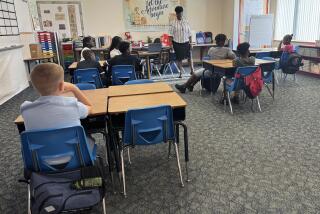Classes Are Growing, Growing, Gone : Escondido Schools May Cap Enrollment to Deal With Crowding
The houses being built on Miller Road in Escondido might seem the perfect place for a young family: three and four bedrooms, good-sized yards and an elementary school right across the street.
But the families buying houses there are being told they will probably have to put their school-age children in a car and drive more than a mile to a different elementary school.
The reason: Miller School, originally designed to handle 540 students, is filled to the brim with 826 children, housed in part in seven relocatable classrooms on playgrounds. As soon as 14 more students are enrolled--and it could happen in a day or in a week--the school will be closed to new admissions. Even children moving into new houses across the street will be told to go elsewhere.
That’s how bad, officials say, the school crowding problem is in Escondido these days.
On the Brink of Capacity
For several years, trustees of the Escondido Union School District have been warning that residential growth was putting the elementary district’s schools on the brink of capacity. And that threshold will be reached tonight, when trustees are expected to adopt a staff recommendation to put enrollment lids on three of the district’s 13 elementary schools: Miller, Central and Lincoln.
No more relocatable classrooms can be installed on the three campuses, officials say, because the schools’ cafeterias, libraries, restrooms, computer labs, playgrounds and other support facilities cannot handle more students.
Miller can handle 14 more children, and in the first and fifth grades only. Central Elementary, which serves the downtown residential core, has room for only two more students, and Lincoln, on the north side of town, is within 11 of reaching capacity, the district has decided.
When capacities are reached, parents of new students in those schools’ attendance boundaries will be told to take their children to other elementary schools in the district by their own means, since there is no district busing.
Both Central and Lincoln serve neighborhoods with greater numbers of apartments, and, as a result, their enrollments tend to fluctuate with a more transient population.
But Miller serves much of Escondido’s growing southwest side, where single-family housing developments are beginning to crown hillsides like the new fall crop.
‘Our Buyers Understood’
Sales managers at some developments not within walking distance of Miller say that, although the news is discouraging, it is not expected to affect home purchasers much.
“Our buyers already understood there’s no busing in the Escondido school district, and they were going to have to take their children to school anyway,” said Ken Walls, sales manager at the 243-unit Rancho Verde development along Via Rancho Parkway. “It’s 2 miles to Miller School, and 3 miles to Juniper Elementary School. Once they’re in the car anyway, I don’t know if they’ll mind terribly driving the extra mile.”
But the student cap at Miller might well cast a pall over the 39 houses in the Boardwalk Estates development directly across from the school. It also represents an irony of sorts.
For years, the vacant property across from Miller was used as an overflow parking lot for parents picking up their children from school. But the development broke ground there last spring, and parents grumbled about the ensuing traffic and parking crunch at the school.
Now the tables seem to have turned on Boardwalk Estates, whose children won’t be admitted to Miller because of the enrollment crunch.
Greg Shull, an executive with G. R. Smith Corp., the developer, said he is discouraged by the news.
‘Pains of Growth’
“You pay your school fees and you fully anticipate there would be space across the street,” said Shull, who estimated his development contributed $100,000 in fees to Escondido’s elementary- and high-school districts.
“We’re all going through the pains of growth, unprecedented growth, and there are many things that are discouraging,” he said. “But there was no indication we couldn’t be served by Miller.”
Shull said he holds out hope that, when district officials redraw school boundaries before next fall, to shift students from crowded schools to those that can accommodate more portable classrooms, his families will find themselves in Miller’s classrooms.
“In the meantime, we’ll tell our people that the school across the street is full, and help them find out what school they will be going to,” he said.
Another developer, Robert Childers, said he is “flabbergasted” by the news, but doubts it will discourage home sales in Carriage Hills, a subdivision on Bernardo Lane with 88 houses under construction that will sell for $300,000 to $400,000 each.
“I’ve already paid around a quarter-million dollars in school fees, and now they’re saying they won’t accept our students at Miller? I’m shocked, and I don’t know how to respond,” Childers said.
But he said he expects few of his home buyers to be affected dramatically by Miller’s closed door.
“Most of our buyers in our price range will be in the position to either send their children to private schools or carry them in a vehicle to the next-closest school.
“But I feel sorry for everyone--including the schools themselves. Proposition 13 (the 1978 property tax-cutting measure) was the worst thing that ever happened,” Childers said.
School board President Barry Baker said the district “has reached a threshold at which we have so many kids at a school, over and above the permanent building capacity, that it’s no longer safe for the kids to go to and from school, and the campus is no longer functional. We’re forced to make this decision.”
The district now has 12,800 students, of which about 3,000 are housed in relocatable classrooms.
To help resolve the crowding, district officials already are planning to open an “instant school” at the city’s Kit Carson Park, a couple of miles from Miller, next fall. The school will be made up entirely of relocatable classrooms and handle 600 students immediately.
But Trustee Sid Hollins noted that, even with a new school next fall, the district is still falling behind because it is expected to grow by 900 students in the next school year.
“Anyone who knows the Escondido housing scene knows we’ve been moving toward an impossible situation,” Hollins said. “And I guess it’s becoming a greater reality every day.”
1,000 More in a Year
The district has grown by 1,000 students in a year, and those were squeezed into existing schools, all of which have come to rely on relocatable classrooms.
A district advisory committee is considering a bond issue to put to the voters next spring, and the district is negotiating with the city for an emergency $10-million loan to help build another school and to acquire one or two new sites.
“Even if we had $50 million in the bank right now and were able to go out and build new schools, we still couldn’t maintain the neighborhood school concept since there are no sites in the neighborhoods where there are too many children,” Hollins said. “Our new school sites are on the periphery of Escondido, and we’re looking at having to make tremendous boundary changes when we do build our new schools.”
Board President Baker said: “We are way behind, because developer fees are restricted by the state of California. Right now we’re paying $1 million a year in developer fees just to rent relocatable classrooms. We’re not getting ahead in building new schools. We need $30 million just to catch up to where we should be.”
In past years, the district implemented--then canceled and then again considered re-implementing--a year-round school schedule that would effectively increase the enrollment capacity of the district by 20%. But the plan met strong resistance among parents, and today, only one school in the district--Conway Elementary--is on a year-round schedule.
More to Read
Sign up for Essential California
The most important California stories and recommendations in your inbox every morning.
You may occasionally receive promotional content from the Los Angeles Times.










